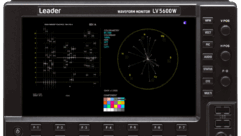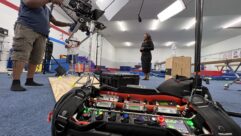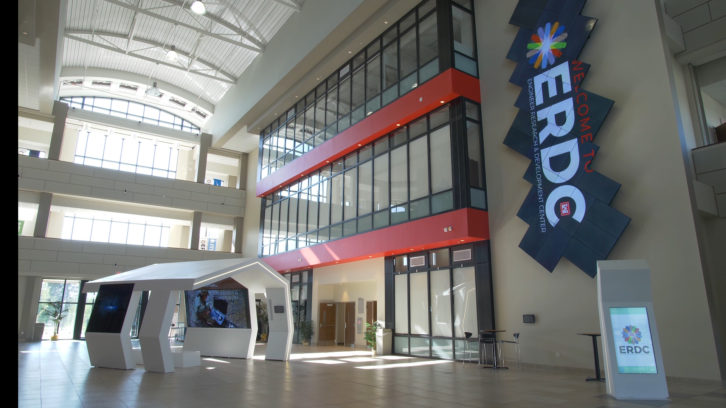
The U.S. Army Corps of Engineer’s Engineer Research and Development Center (ERDC) strives to be the premier public engineering and environmental sciences research and development organization. As such, the Corps recently reimagined its headquarters building in Vicksburg, Mississippi.
The stated objective of this upgrade was to educate visitors on the role of the ERDC and learn about government research, as well as providing working spaces and inspiration for the engineers, staff, visitors, government officials and conference-goers who do important work for the country in this vibrant center.
As such, the remodel strove to expand the definition of AV in a working government building.
ERDC hired Nashville-based M3 Technology Group, an audiovisual integrator based in Nashville, Tennessee, to create a unique audio-visual experience not seen in other government facilities. To maximize appeal to visitors, M3 tapped into a trend that’s seen in corporate lobbies to create a dramatic atrium display environment. The new display environment creates an immersive space with soaring mosaic video walls, and a unique AV walkthrough centerpiece.
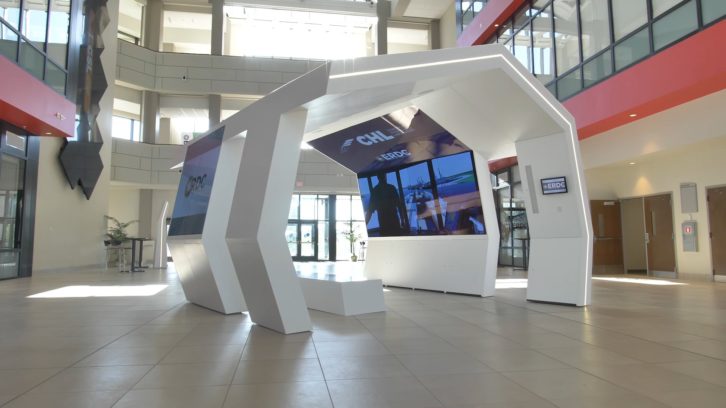 As they enter the building, people encounter two 32’ high mosaic video walls composed of 30 LG VMC5 series displays, 19 55” models and 11 46” models. These displays fit the contractual requirement of providing an ultra-wide viewing angle and ultra-thin bezels. The signal to these walls is driven by a Crestron Digital Media switching backbone and an RGB Spectrum Galileo video processor to handle the custom content.
As they enter the building, people encounter two 32’ high mosaic video walls composed of 30 LG VMC5 series displays, 19 55” models and 11 46” models. These displays fit the contractual requirement of providing an ultra-wide viewing angle and ultra-thin bezels. The signal to these walls is driven by a Crestron Digital Media switching backbone and an RGB Spectrum Galileo video processor to handle the custom content.
In the heart of the atrium, the immersive Pavilion installation is encased on both sides by custom structure are 14 LG OLED 65EV5C displays. These OLED video wallpaper displays allow the folks at ERDC to convey their mission in a stunning manner. Typical content includes information about each of the labs on base and their core functions.
The custom content in the atrium is driven by RGB Spectrum’s Galileo video wall processors, chosen for their display layout flexibility, ability to output to multiple walls, and image quality. The Galileo processors receive feeds from digital signage players, media servers, and PCs with custom-created content. In the immersive pavilion, a single Galileo processor outputs this content in portrait orientation to two OLED video walls; a 2 x 5 video inside the Immersive Pavilion structure and a 1 x 4 video wall on its exterior. Two additional Galileo processors drive the 32-foot high 15-monitor mosaic video walls presented vertically.
The mosaic video walls posed particular challenges. First, the images feeding the displays needed to be rotated in a variety of angles. Secondly, the processors had to support two different display sizes, 55 and 45-inches, intermixed in the digital signage mosaic. Thus, the processors had to scale the output for each display and properly align them to form a seamless image. Galileo produced a seamless, contiguous visual across the multi-screen mosaic with the desired visual appeal.
Having made a statement in the atrium about the vision and mission of the ERDC, hosts often lead guests to the auditorium space for large scale meetings, panels and workshops that focus on the work that has been done and on the job ahead. These gatherings often need to be webcast as well and, as such, the auditorium needed to be versatile and impressive in its own right.
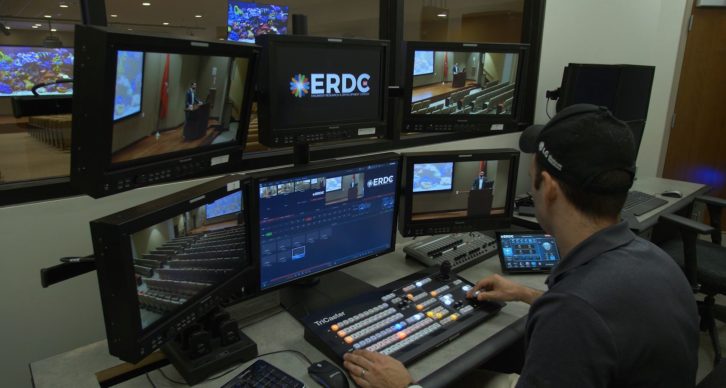 The contract specification called for two Barco F90 4K 13 laser phosphor projectors, which are just under 12k lumens. These projectors are driven by an Extron Quantum Elite video processor for edge-blending and image scaling, enabling the projectors to give the appearance of multiple displays or one large display. Audio in the space is handled by two Biamp Tesira Servers for DSP that feed QSC CX series amps and drive an assortment of Tannoy speakers, including the QFlex 16 steerable column arrays, VX12s and CVS 8s. With this setup, the space can be setup for both typical speaking engagements as well as more robust live events.
The contract specification called for two Barco F90 4K 13 laser phosphor projectors, which are just under 12k lumens. These projectors are driven by an Extron Quantum Elite video processor for edge-blending and image scaling, enabling the projectors to give the appearance of multiple displays or one large display. Audio in the space is handled by two Biamp Tesira Servers for DSP that feed QSC CX series amps and drive an assortment of Tannoy speakers, including the QFlex 16 steerable column arrays, VX12s and CVS 8s. With this setup, the space can be setup for both typical speaking engagements as well as more robust live events.
The production side of the auditorium is driven by a Tricaster 410 system and 4 Sony BRC-H900 cameras controlled from the production booth located in the rear of the room. This professional broadcast system allows events to be recorded and distributed all over the world.
In addition to the auditorium, the ERDC facility also features a number of high-tech classrooms and conference rooms to facilitate the transfer of knowledge, all supported with AV displays.
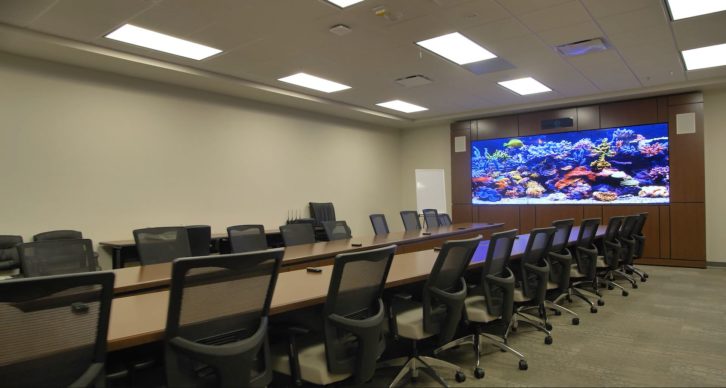 In addition to the public-facing aspects of the facility, the building also a functioning component of the Corps of Engineers and, as such, has some impressive technology that isn’t open to its visitors.
In addition to the public-facing aspects of the facility, the building also a functioning component of the Corps of Engineers and, as such, has some impressive technology that isn’t open to its visitors.
In the Emergency Operations Center, an 2×3 video wall composed of LG VMC5 series 55” Video wall monitors and Extron Quantum Connect video processors ensures that anytime an emergency arises, the Corps is prepared to assess and assist in the situation. Video signal is distributed by a Crestron Digital Media switcher and endpoints while audio is handled by Shure Microflex wireless mics and Audix wired microphones feeding a Biamp Tesira Server-IO and amplified by Extron XPA series amps.
Video conferencing capabilities are handled by a Cisco SX80 allowing seamless communication with other remote sites and the entire system is tied together by a Crestron control system.
In addition to the EOC, the secure facility features two other large scale video conferencing suites where secure communications can take place once again through LG video walls, Crestron DM switching and control and a Cisco SX80 video codecs. A control room leveraging Crestron’s 3-series processors and TSW Series touch screens services both of these VTC suites, enabling an operator to setup and configure calls for all near-end participants. Discussions and communication that take place in these secure rooms ultimately ensure the mission and vision of the ERDC are carried out effectively and reliably for the advancement of the country.
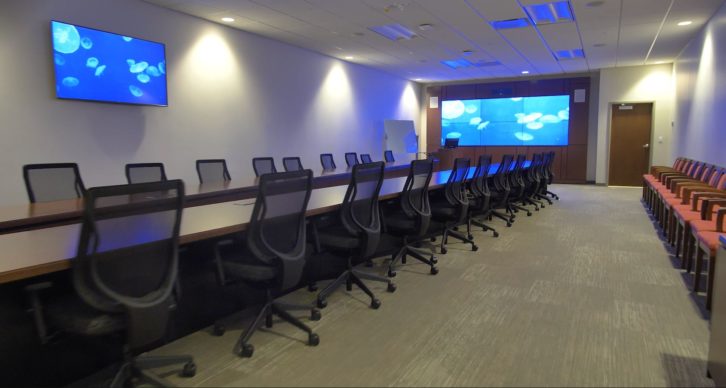 Editors Note: Due to governmental policies on affiliation and endorsement, it should be noted that this case study does not imply USACE endorsement of any of the solutions.
Editors Note: Due to governmental policies on affiliation and endorsement, it should be noted that this case study does not imply USACE endorsement of any of the solutions.
Product At Work:
The Galileo processor supports real-time throughput of inputs and outputs at up to 4K resolution. The processor offers the flexibility to output in rotated and portrait orientation, and display content in windows of any size, anywhere on the video wall. Display layouts can be changed instantly to focus on particular areas of interest. Operators can select preset display layouts, switch and route sources, and size and position windows. Image overlap capability is available for projector-based video walls, custom timings accommodate the special resolutions of LED walls, and bezel compensation optimizes viewing with LCD video walls. Advanced features include a unique “wall mimic– the entire video wall or any region of interest can be encoded and streamed for live viewing elsewhere; HDCP content protection, scripting for third party system control, and automatic IP stream discovery for RGB Spectrum’s Zio AV-over-IP encoders is included.


